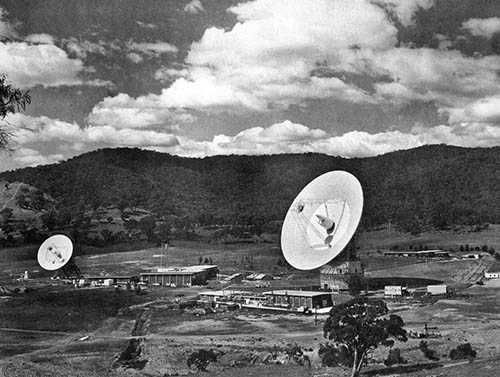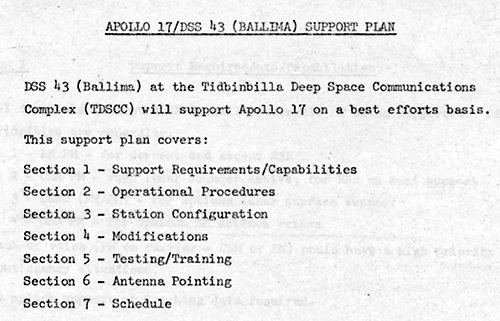During 1971 and 1972, construction of the new 210 foot (64 metre) antenna at Tidbinbilla was progressing.
DSS-43 would be a sister antenna to the Mars Dish (DSS-14) at Goldstone. By the time of Apollo 17, the antenna would be partially operational, lacking the Master Equatorial system which would allow it to be driven as if it had an equatorial mount. (The antenna was not officially opened until April 1973.)
DSS-43 supported Apollo 17 on a “best effort” basis. The tracks are listed in Hamish Lindsay’s essay.
|
The newly completed 64 metre DSS-43 at right, dwarfs the DSS-42, the original Tidbinbilla antenna, at 26 metres.
This photo was reproduced in the DSS-43 opening souvenir booklet.
Large, Larger. From Bryan Sullivan’s copy. |
Mike Dinn explained to Hamish Lindsay:
“It was decided that I would go to the Jet Propulsion Laboratory (JPL) during the calendar year 1972 to facilitate and coordinate the new 64 metre antenna DSS 43. I was attached to a systems section at JPL for a year.
Along the way, Tom Reid, Station Director at Tidbinbilla, and I determined that there was a good chance that DSS 43 could be finished, or finished enough to support Apollo 17, and we both though it would be a good target for everyone concerned. I also saw it as an opportunity to work back in manned flight, which I left after Apollo 13. So I worked with Goddard and Houston, and with Tom Reid and Tidbinbilla and JPL to facilitate the support of Apollo 17 by DSS 43 on a best effort basis. I had a couple of meetings at Goddard, then I got to Houston for a couple of meetings with people like Tom Sheehan. It also gave me an excuse to be at Houston for the launch of Apollo 17. I wrote the support plan for that particular activity.”
|
The DSS-43 Support Plan for Apollo 17 – a 3.5MB PDF file.
With thanks to Mike Dinn, scan by CM. |
And Bruce Window remembers:
“After supporting Apollo 15 as Ops Supervisor at Tidbinbilla Wing-site (HSKX) together with Tony Keiller, I took some leave in August/September 1971. At that stage I was employed by AWA. While on holidays with my family at the Gold Coast I got a telegram from the AWA senior company rep at Tidbinbilla saying that the Department of Supply (DOS) wanted me to be in JPL Pasadena in two weeks time. The job was Implementation Coordinator for the 64 metre antenna at Tidbinbilla and would mean six months work at JPL. I was to be an interface between the JPL Engineering sections under the control of Bill Merrick and the Tidbinbilla DOS Station Management and AWA management.
Somehow, I got myself to JPL within the two weeks, and got my family across some 10 days after that. Frank Northey (DOS) who was the nominal Station Director of the new 64 metre station was my main contact at Tidbinbilla as well as the AWA Chief Engineer on site (John Cummings I think).
Having been involved in all of the Apollo missions from either HSKX or Parkes, I saw the advantage of pushing the 64m construction timetable in various engineering meetings for the CDE’s (cognizant design engineer) to recognise that it would be a big cudos to JPL for the 64m to be operational enough to track Apollo 17 on a best effort basis. I won’t claim that I was the first or only one to think this way, but I know that I raised it a number of times with Bill Merrick or his engineers.
Just as my 6-month period was concluding Mike Dinn arrived in JPL with his family to carry on the job at an Operational Management level. I went back at Tidbinbilla to do the coordination for the equipment installation and the cabling to the 64m dish working to Frank Northey and my chief engineer. After I got back to Canberra in March/April 1972 I found I had come back with pneumonia. This kept me off work for a crucial couple of weeks. At Tidbinbilla, we worked hard with the installation, having Apollo 17 as an unofficial target.
When the 64m at Tidbinbilla supported Apollo 17, I was very satisfied to be the Ops Supervisor sitting at the DSS43 station management console. The intercom position designation of SB3 for the mission was quaint bearing in mind the seemingly long history of Tidbinbilla only having SB2 for Apollo missions.”

